This post may contain affiliate links. Please read our privacy policy.
Having trouble with getting your baked goods to turn out correctly? Sometimes the solution is simpler than you think! Learn how to measure flour correctly to avoid some basic baking errors.
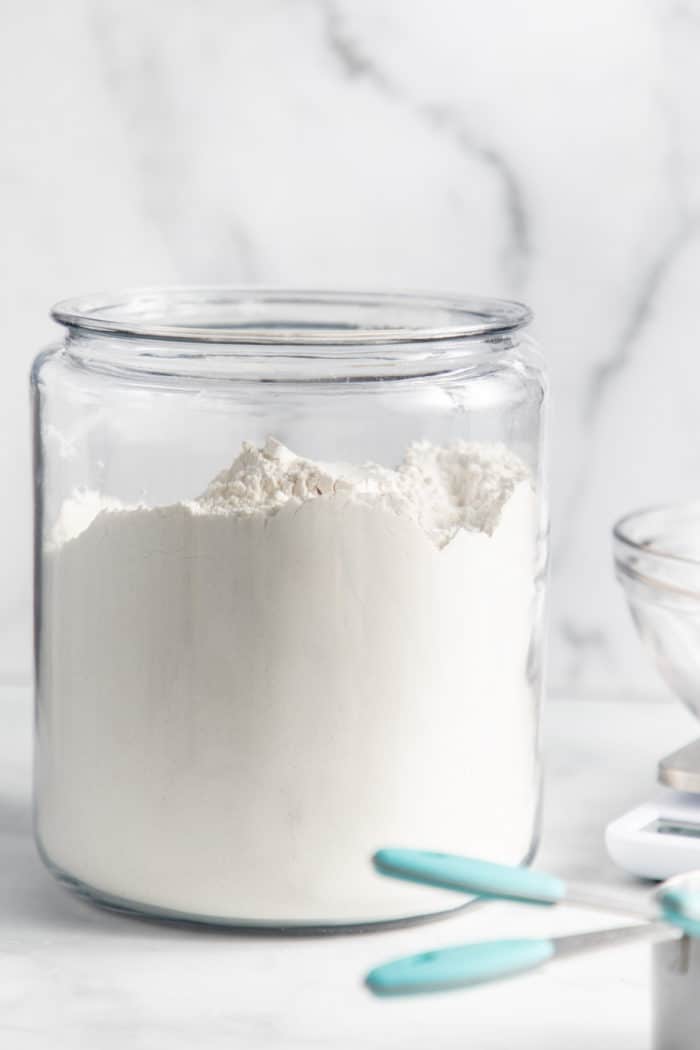
As a food blogger, I try to provide my readers with great recipes that have been tested thoroughly in my kitchen.
However, sometimes a recipe that worked well for me turns out a little less than perfect for a friend or reader.
Whenever my friends ask me why something didn’t turn out right – whether it’s my favorite chocolate chip cookies, the best chocolate cake, or homemade Bisquick, typically the first question I ask is, “How did you measure the flour?”
For years I thought dipping the measuring cup directly into the flour sack was an accurate means of measurement. However, when I started to teach myself how to bake – I realized this method can be pretty inaccurate.
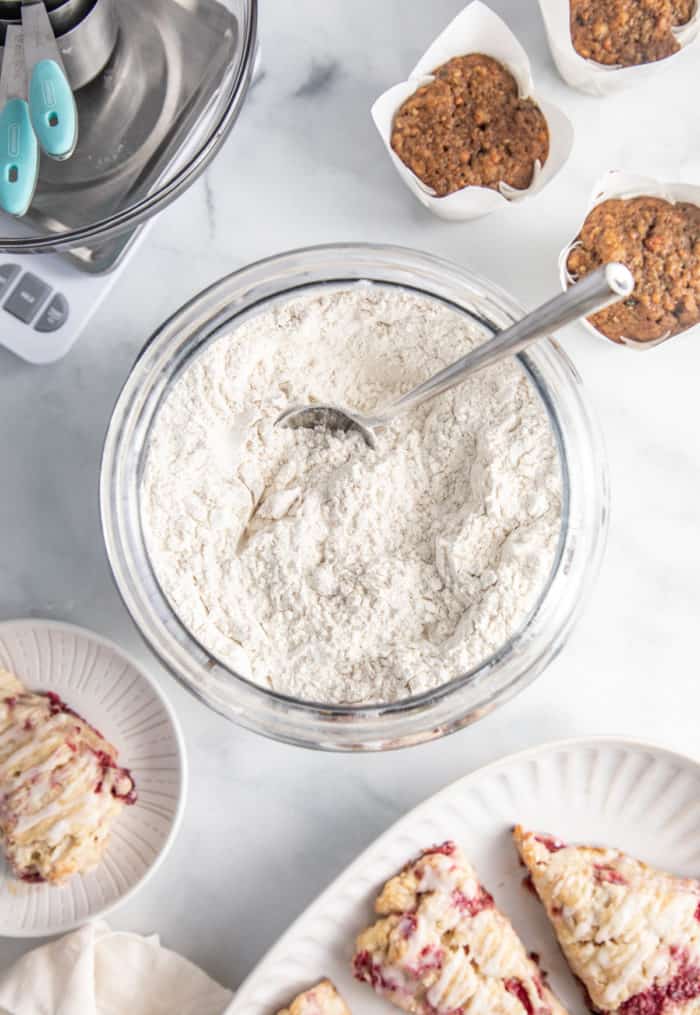
Pin this now to find it later
Pin ItWhy Your Measuring Method Matters
I decided to conduct a little kitchen experiment and measure a cup of all-purpose flour two ways.
Here were the results:
- Scooping a measuring cup into the flour and leveling: 6 oz in weight
- Spooning the flour into a measuring cup and leveling: 4.25 oz in weight
Pretty big difference, right? Especially when it comes to baking. Because just a couple extra ounces of flour can really change the texture of a baked good.
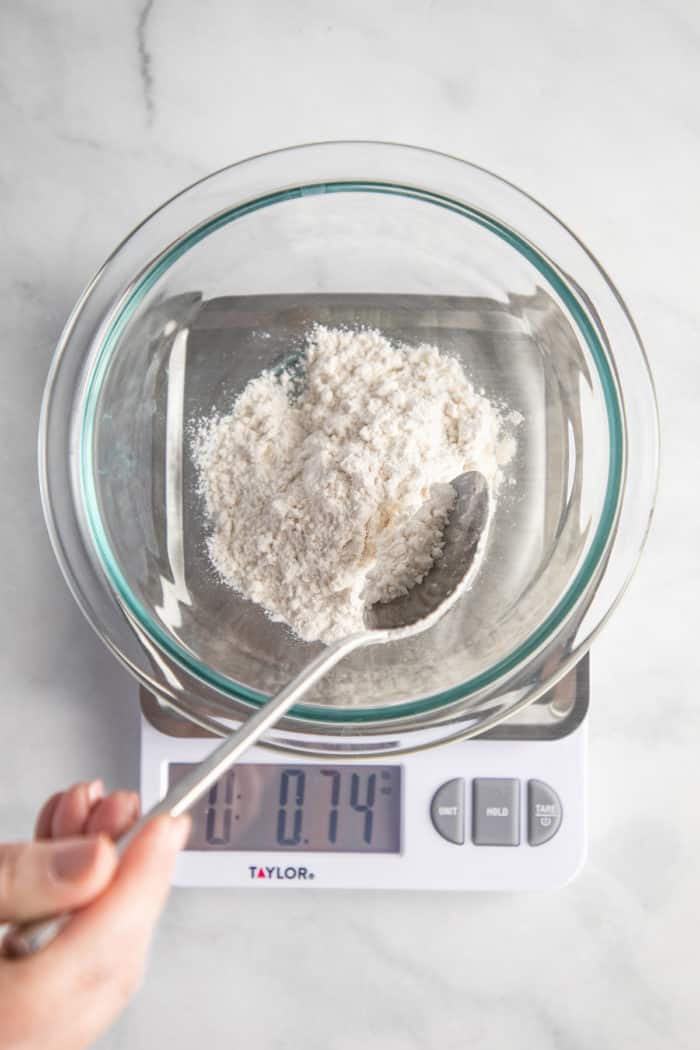
The important thing to remember is that, much like brown sugar, flour packs. Scooping the ingredient with your measuring instrument will cause packing.
Packed flour can add up quickly!
If you have a recipe with 3 cups of flour, and you scoop using your measuring cup, you could end up with 18 ounces of flour, when in reality you should have 12.75 ounces of flour.
That’s nearly an extra 3/4 cup of flour in your recipe!
That can dramatically change the results you get from a finished baked good.
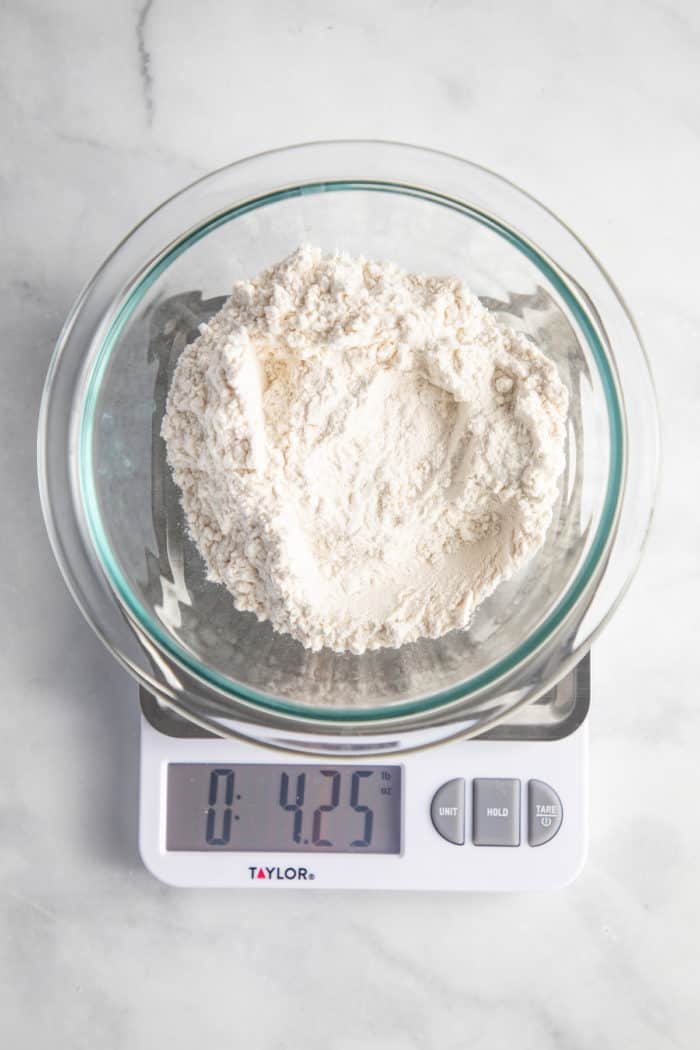
How to Measure Flour for Baking
Flour measurements can be one of the biggest variables when it comes to the finished product in baking. Weighing ingredients is by far the most accurate, but not a common practice here in the U.S.
If you’re an Alton Brown fan – like I am – you know from Good Eats that this is pretty much the only way he measures dry ingredients.
A digital scale can come in handy and is useful for more than just measuring your sugar and flour.
I use mine a lot to weigh small packages for click and ship labels via USPS, and they are also great for figuring out correct portions of meat and other items when needed.
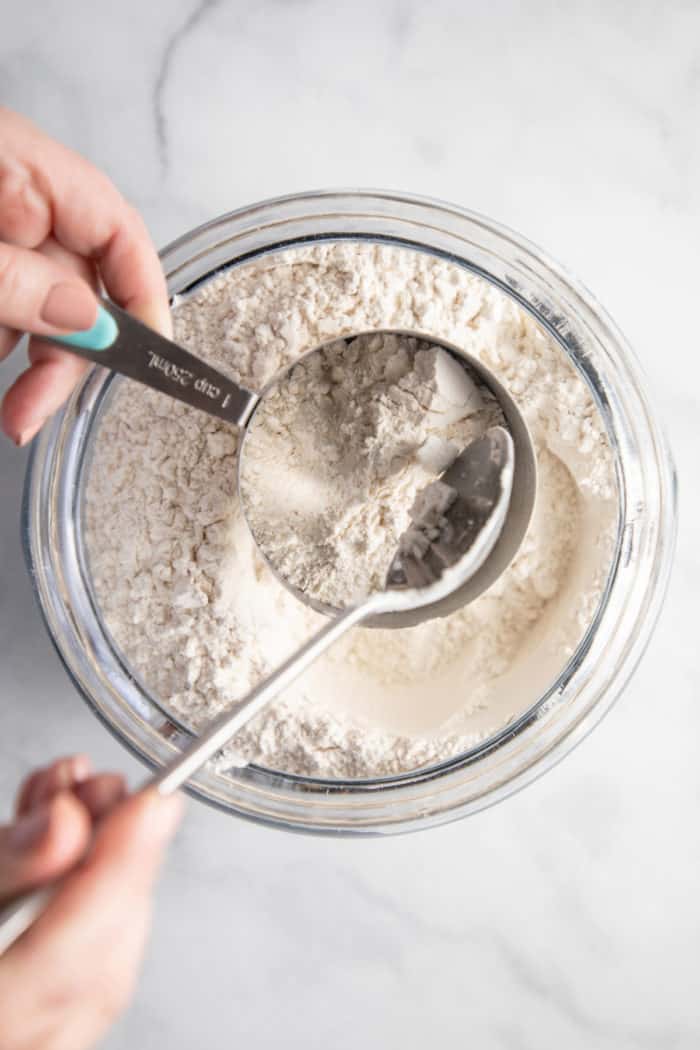
How do I Measure Flour Without a Scale?
If you don’t own a scale, when it comes to dry ingredients, you’re more than likely using a measuring cup.
Many people use measuring cups with perfect results. But remember that they can be incredibly inaccurate depending upon the method of adding the flour to the cup that you use.
What measuring cups should you use?
Although I grew up using both liquid and dry measuring cups, I’ve come to realize through blogging that a lot of people don’t own both types of cups and some don’t know that two types of measuring cups exist.
So, let’s start with the basics – if you’re going to bake, I strongly recommend picking up a set of dry measuring cups as well as at least one liquid measuring cup.
Both can be found in pretty much any store including places like Target, Amazon, the grocery store and even the dollar store.
Make sure you use the dry measuring cups for measuring flour, sugar, and other dry ingredients. Save the liquid measuring cup for milk, water, and other liquid ingredients.
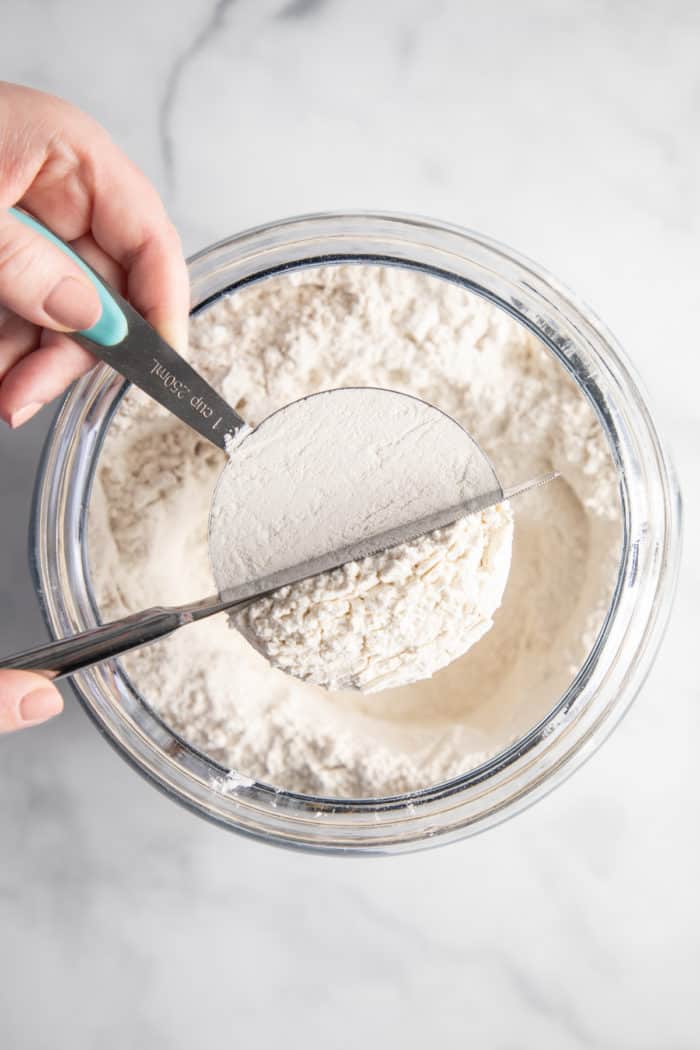
How to get an accurate flour measurement with a measuring cup
Here’s how to get a pretty accurate measurement without the use of a scale:
- Use a spoon to fluff up the flour within the container.
- Use a spoon to scoop the flour into the measuring cup.
- Use a knife or other straight edged utensil to level the flour across the measuring cup. I have a plastic straight edge that I keep in my flour bin at all times for just this purpose.
And that’s it! Now you know how to measure flour the right way so your baked goods are as perfect as possible.
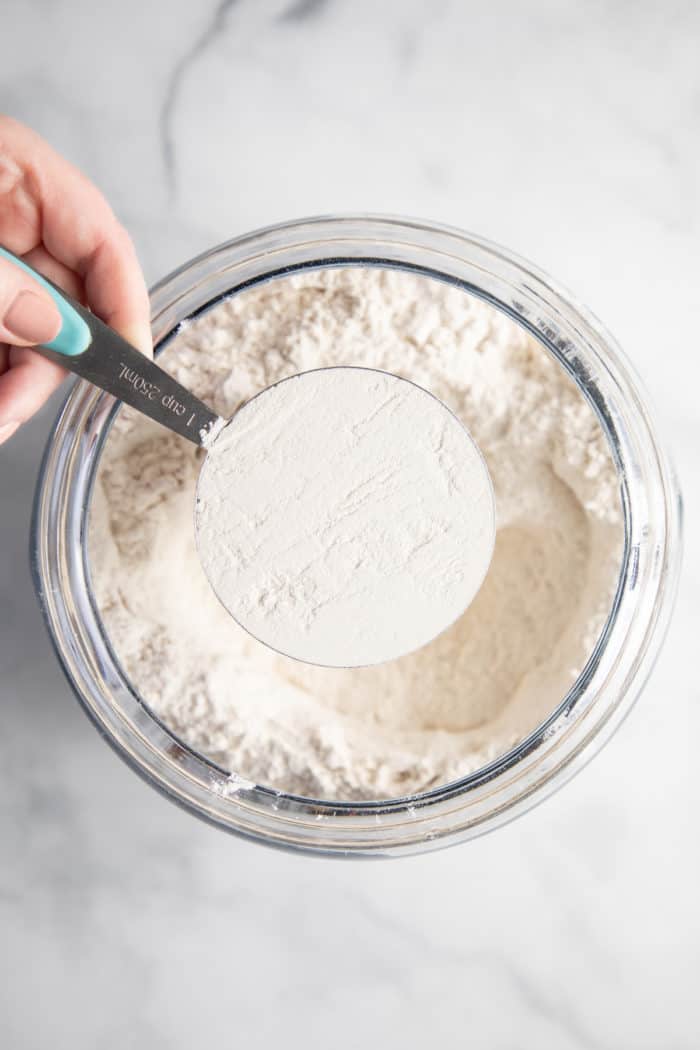
Commonly Used Weight Measurements
Here are some helpful common volumetric measurements and their weight equivalents for quick reference.
All measurements are in ounces by weight, not fluid ounces.
Flours
- all-purpose flour: 1 cup weighs 4.25 ounces
- cake flour: 1 cup weighs 4 ounces
- bread flour: 1 cup weighs 4.25 ounces
Sugars
- granulated white sugar: 1 cup weighs 7 ounces
- confectioners’ sugar (powdered sugar); unsifted: 1 cup weighs 4 ounces
- light or dark brown sugar; packed: 1 cup weighs 7.5 ounces
Butter
- butter: 1 cup weighs 8 ounces
I also definitely recommend printing out a copy of this Ingredient Weight Chart from King Arthur Flour. I laminated mine because I am kind of a messy baker. The list hangs from the side of my fridge, and I can honestly say it is one of my most used kitchen resources.
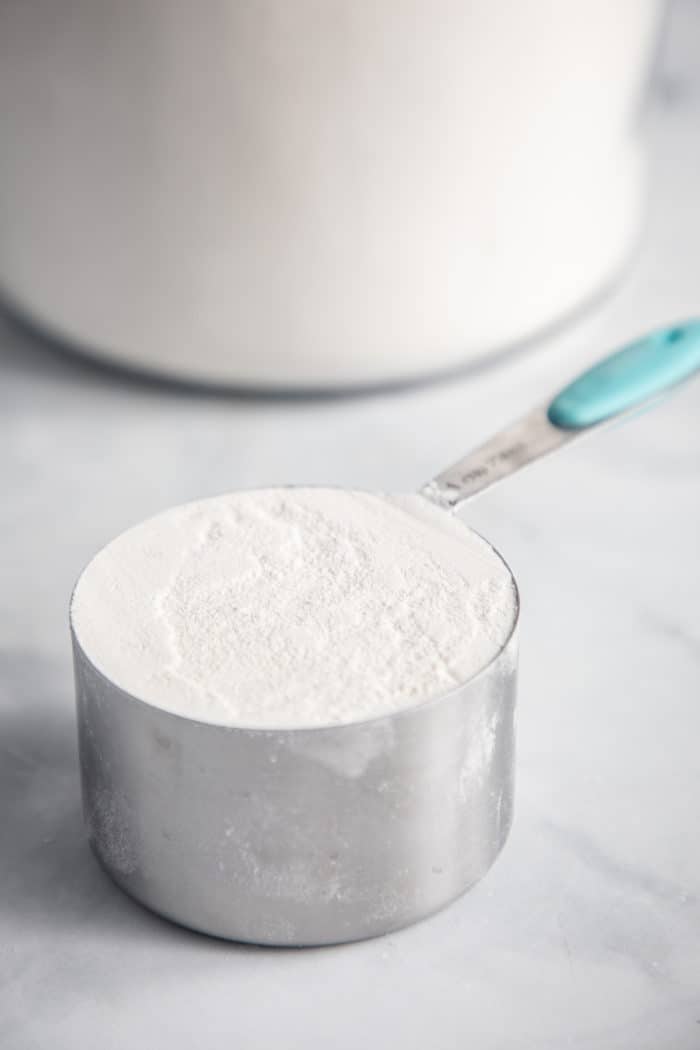
More Helpful Kitchen Tips
Whether you’re a beginner baker or a veteran in the kitchen, there are a few kitchen substitutes and tips that are helpful to keep in mind.
Whip up this simple buttermilk substitute to use in any baking recipe calling for buttermilk.
This brown sugar substitute is also a handy trick to keep in mind in case you find yourself out of brown sugar while in the middle of baking.
It’s also handy to know how to soften butter and how to soften cream cheese quickly! I always forget to set mine out, so I use these tricks all of the time.
How to Measure Flour
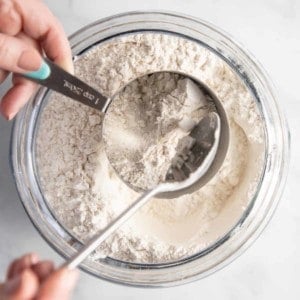
Equipment
- Spoon
- Knife or other straight-edged utensil
Ingredients
Instructions
- Use a spoon to fluff up the flour within the container.
- Use a spoon to scoop the flour into the measuring cup.
- Use a knife or other straight-edged utensil to level the flour across the measuring cup. I have a plastic straight edge that I keep in my flour bin at all times for just this purpose.
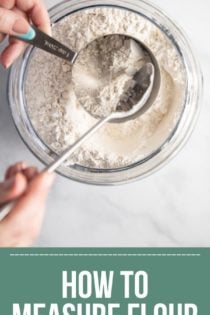
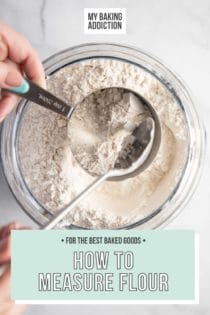
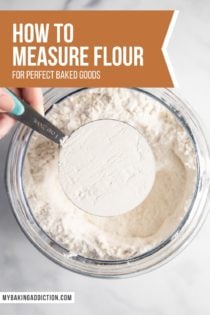
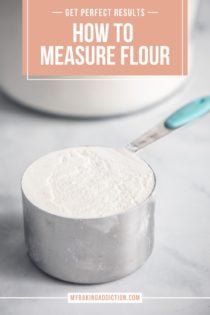
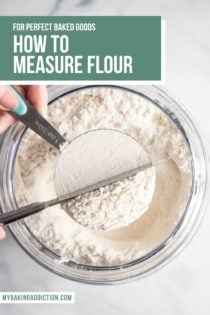









Hi,
your recipes are really good and easy to make! I just wonder from all your recipes what is the “best seller”? :)
Hi, Tam! I would say The Best Chocolate Cake is pretty popular: https://www.mybakingaddiction.com/the-best-chocolate-cake-recipe/. Thank you so much for your kind words!
ok, if a recipe call for lets say 2 cups of Sifted flour then you should sifted first then measured out.
now if a recipe calls for 2 cups of flour sifted then you measure it then sift it.
it all depends on which way the recipe is written. so if the word sifted comes before the word flour you have to sift it first then measure, and if it comes after the word flour then you can measure it then sift it.
just look at the order of the words.
sifted flour – sift first
flour sifted – sift second.
hope this can helps every one out.
Thanks, Emily!
Hi! I just wanted to add something to your post. I live in the Denver area, and I used to weigh all my dry ingredients. I would have issues with my breads and cake and cupcakes falling in the middle. After much trial and error I have discovered that when cooking at altitude it is important to add an extra 1/4 cup of flour to keep things from sinking in the middle.
Thanks!
Thanks so much, Sara! I appreciate your insight. Have a great day!
-Jamie
@Sara F.,
I live in CO as well and cooking in high altitude locations is a big problem in the kitchen. I lived in FL for 22 years and after moving to CO I have had to adjust almost everything…even boiling pasta!
Thank you so much! I am a huge Alton fan which is why I bought a scale. My cake has been coming out pretty dense and I love how your blog breaks down the measuring and weighing so I can now always make sure I have the right amount of flour.
Carrie-
I’m so glad that you found this post helpful. Thanks for stopping by.
-Jamie
Updated link for the weight chart: http://www.kingarthurflour.com/recipe/master-weight-chart.html
Sandy-
Thanks for stopping by with that updated link.
-Jamie
Does it matter what type of spoon we use to scoop the flour and then put in our measuring cup?
Any spoon will work. Thanks for stopping by.
-Jamie
So I just ran across this recipe (found here: http://feelingfoodish.com/white-velvet-butter-cupcakes-with-vanilla-buttercream-frosting/ ), and it shows the measurements in cups and in ounces… I bring this up because I feel like the flour measurement is wrong, and I would like your opinion on the matter… It says 3 cups sifted cake flour or 10.5 ounces… Is it less because it’s sifted first? (I’m under the assumption that it should equal out to 12 ounces since one cup of cake flour is four ounces…). I’m making 120 of these cupcakes (plus a two tier cake – different recipe) for my brother-in-law’s wedding this weekend, and I am making a list of the amount of ingredients I need because the bride is insisting on at least paying for the ingredients (bless her heart), and I don’t want to accidentally buy too much and overcharge her… Thoughts? Advise? Thank you in advance! :-) … I should also mention that I have made these dozens of times using regular dry measuring cups, sifting the flour first, and then scooping the flour into the measuring cup and leveling it off… They always come out beautifully (FANTASTIC bakery-style texture), but I figure adding up the ingredients in ounces will help me get a better idea of the amount of ingredients to buy. Thanks, and sorry for the rambling!
You might contact the site with the recipe and check with them. It’s hard for me to say without having made the recipe.
-Jamie
If a recipe calls for sifted flour, do you sift before or after measuring the flour? Thanks so much.
Michelle, you sift it after you measure it.
– Jamie
Do I sift the flour first and then measure or measure and then sift? Some recipes mention the amount and flour required and then sift. I just came across a pastry recipe that suggests sifting the flour and then measuring the required amount.
I am confused. Please help.
Usha, I think most people measure then sift. I would do that unless the recipe specifies otherwise.
– Jamie
This conversion information was really helpful for a recipe I’m making that had granulated sugar measured out in ounces. Thanks so much!!